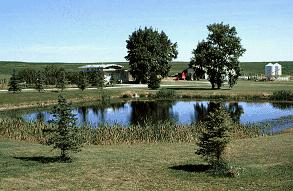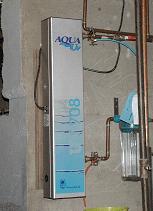| |

Dugouts and Small Ponds | Groundwater and Wells | Raw water distribution lines | Small-scale Water Treatment Systems | Distribution-Systems
Dugouts and Small Ponds
Dugouts and small ponds are naturally more prone to stagnation and stratification than larger water bodies such as lakes and reservoirs. The lack of mixing from inflow, wind, and water currents produce these conditions, which can result in a variety of sampling approaches.

The most common way to take a representative sample from a pond or dugout is to obtain a sample representative of the entire depth (depth integrated sample). This sample would normally be taken over the entire depth of the water column in the middle of the dugout or pond.
Sampling for specific reasons may require the use of a discrete sampler, which allows a specific zone or depth to be targeted, such as when groundwater influence is suspected. Depth integrated samplers are more commonly used for dugouts and small ponds.
Groundwater and Wells
To obtain a sample representative of the aquifer itself the well requires purging before sample collection to eliminate stagnant water. The stagnant water must be removed as it will not be representative of the water from the aquifer entering your well. The method and rate of purging, time between purging and sampling, and sampling itself will depend on the well's diameter, depth, and recharge rate. The well should not be pumped beyond its recommended flow rate during testing as damage can occur to the aquifer.
Each well should be slug, pressure, or pump tested to determine the hydraulic conductivity of the formation and to estimate the extent and rate of purging prior to sampling. You may want to consult a hydrogeologist or a certified well driller for assistance with this type of sampling if you are unsure.
A standard purge volume obtains a stabilized concentration of the parameter of interest. Purge volumes usually range from three to ten well volumes. This will result in a significant amount of water being purged from the well.
In general, a sample should only be taken after the pH, electrical conductivity, and temperature have stabilized.
In order to more accurately determine the water quality of the aquifer, groundwater sampling for municipal and domestic wells is best at a location prior to any purification/treatment process. Chlorination, filters, softeners, and other treatments, including iron, acid and potash, may chemically alter or physically absorb the water quality parameters of interest in the raw source water.
Raw water distribution lines
Raw-water distribution lines such as a pasture pipeline for livestock are generally sampled directly from the distribution line or valve such as near a trough. After a sampling point is selected, the distribution line is equipped with a sample valve. Velocity and flow rate can be important factors to note due to their effects on water quality in a pipeline. The flowrate should be maintained constant during sampling.
Small-scale Water Treatment Systems |  |
| Generally, most small-scale treatment systems routinely sample both the raw water source being treated and the treated water being produced. This is done to identify variations in the source water as well as to ensure the treatment system is adequately treating the water. Without sampling both locations (raw and treated), it is difficult to determine where the problem is when a noticeable change takes place in the quality of the treated water. The quality of the source water may change, or a problem may occur with the performance of the treatment system, or both. |  |
 | If you wish to be able to test or troubleshoot specific components (i.e. iron filter, softener, sand filter, carbon filter, etc.) within your treatment system, sample points should be established at every point where a measurable change is expected in the treated water quality. This method of testing can be beneficial when trying to identify a specific problem within the treatment system. |
Distribution Systems
Distribution-system sample points are used to determine the quality of water being delivered at various points beyond the source or treatment system (i.e. barn nozzle, kitchen faucet). Samples may be of significantly different quality than samples taken at the treatment system or source.
Corrosion, biofouling, and precipitation of elements from the water are common problems in distribution systems and therefore sampling and testing at various points in the distribution system can be useful. |
|